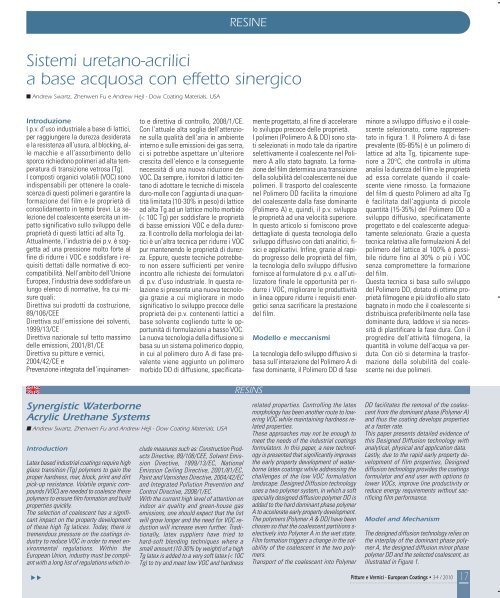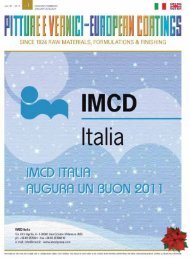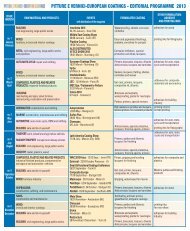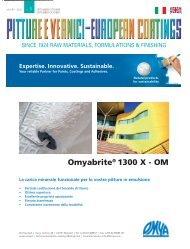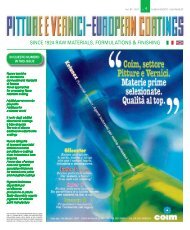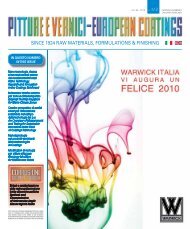Create successful ePaper yourself
Turn your PDF publications into a flip-book with our unique Google optimized e-Paper software.
Sistemi uretano-acrilici<br />
a base acquosa con effetto sinergico<br />
■ Andrew Swartz, Zhenwen Fu e Andrew Hejl - Dow Coating Materials, USA<br />
Introduzione<br />
I p.v. d’uso industriale a base di lattici,<br />
per raggiungere la durezza desiderata<br />
e la resistenza all’usura, al blocking, alle<br />
macchie e all’assorbimento dello<br />
sporco richiedono polimeri ad alta temperatura<br />
di transizione vetrosa (Tg).<br />
I composti organici volatili (VOC) sono<br />
indispensabili per ottenere la coalescenza<br />
di questi polimeri e garantire la<br />
formazione del film e le proprietà di<br />
consolidamento in tempi brevi. La selezione<br />
del coalescente esercita un impatto<br />
significativo sullo sviluppo delle<br />
proprietà di questi lattici ad alta Tg.<br />
Attualmente, l’industria dei p.v. è soggetta<br />
ad una pressione molto forte al<br />
fine di ridurre i VOC e soddisfare i requisiti<br />
dettati dalle normative di ecocompatibilità.<br />
Nell’ambito dell’Unione<br />
Europea, l’industria deve soddisfare un<br />
lungo elenco di normative, fra cui misure<br />
quali:<br />
Direttiva sui prodotti da costruzione,<br />
89/106/CEE<br />
Direttiva sull’emissione dei solventi,<br />
1999/13/CE<br />
Direttiva nazionale sul tetto massimo<br />
delle emissioni, 2001/81/CE<br />
Direttiva su pitture e vernici,<br />
2004/42/CE e<br />
Prevenzione integrata dell’inquinamen -<br />
Synergistic Waterborne<br />
Acrylic Urethane Systems<br />
Introduction<br />
Latex based industrial coatings require high<br />
glass transition (Tg) polymers to gain the<br />
proper hardness, mar, block, print and dirt<br />
pick-up resistance. Volatile organic compounds<br />
(VOC) are needed to coalesce these<br />
polymers to ensure film formation and build<br />
properties quickly.<br />
The selection of coalescent has a significant<br />
impact on the property development<br />
of these high Tg latices. Today, there is<br />
tremendous pressure on the coatings industry<br />
to reduce VOC in order to meet environmental<br />
regulations. Within the<br />
European Union, industry must be compliant<br />
with a long list of regulations which in-<br />
to e direttiva di controllo, 2008/1/CE.<br />
Con l’attuale alta soglia dell’attenzione<br />
sulla qualità dell’aria in ambiente<br />
interno e sulle emissioni dei gas serra,<br />
ci si potrebbe aspettare un’ulteriore<br />
crescita dell’elenco e la conseguente<br />
necessità di una nuova riduzione dei<br />
VOC. Da sempre, i fornitori di lattici tentano<br />
di adottare le tecniche di miscela<br />
duro-molle con l’aggiunta di una quantità<br />
limitata (10-30% in peso) di lattice<br />
ad alta Tg ad un lattice molto morbido<br />
(< 10C Tg) per soddisfare le proprietà<br />
di basse emissioni VOC e della durezza.<br />
Il controllo della morfologia dei lattici<br />
è un’altra tecnica per ridurre i VOC<br />
pur mantenendo le proprietà di durezza.<br />
Eppure, queste tecniche potrebbero<br />
non essere sufficienti per venire<br />
incontro alle richieste dei formulatori<br />
di p.v. d’uso industriale. In questa relazione<br />
si presenta una nuova tecnologia<br />
grazie a cui migliorare in modo<br />
significativo lo sviluppo precoce delle<br />
proprietà dei p.v. contenenti lattici a<br />
base solvente cogliendo tutte le opportunità<br />
di formulazioni a basso VOC.<br />
La nuova tecnologia della diffusione si<br />
basa su un sistema polimerico doppio,<br />
in cui al polimero duro A di fase prevalente<br />
viene aggiunto un polimero<br />
morbido DD di diffusione, specificata-<br />
■ Andrew Swartz, Zhenwen Fu and Andrew Hejl - Dow Coating Materials, USA<br />
▼<br />
▼<br />
clude measures such as: Construction Products<br />
Directive, 89/106/CEE, Solvent Emission<br />
Directive, 1999/13/EC, National<br />
Emission Ceiling Directive, 2001/81/EC,<br />
Paint and Varnishes Directive, 2004/42/EC<br />
and Integrated Pollution Prevention and<br />
Control Directive, 2008/1/EC.<br />
With the current high level of attention on<br />
indoor air quality and green-house gas<br />
emissions, one should expect that the list<br />
will grow longer and the need for VOC reduction<br />
will increase even further. Traditionally,<br />
latex suppliers have tried to<br />
hard-soft blending techniques where a<br />
small amount (10-30% by weight) of a high<br />
Tg latex is added to a very soft latex (< 10C<br />
Tg) to try and meet low VOC and hardness<br />
RESINE<br />
RESINS<br />
mente progettato, al fine di accelerare<br />
lo sviluppo precoce delle proprietà.<br />
I polimeri (Polimero A & DD) sono stati<br />
selezionati in modo tale da ripartire<br />
selettivamente il coalescente nel Polimero<br />
A allo stato bagnato. La formazione<br />
del film determina una transizione<br />
della solubilità del coalescente nei due<br />
polimeri. Il trasporto del coalescente<br />
nel Polimero DD facilita la rimozione<br />
del coalescente dalla fase dominante<br />
(Polimero A) e, quindi, il p.v. sviluppa<br />
le proprietà ad una velocità superiore.<br />
In questo articolo si forniscono prove<br />
dettagliate di questa tecnologia dello<br />
sviluppo diffusivo con dati analitici, fisici<br />
e applicativi. Infine, grazie al rapido<br />
progresso delle proprietà del film,<br />
la tecnologia dello sviluppo diffusivo<br />
fornisce al formulatore di p.v. e all’utilizzatore<br />
finale le opportunità per ridurre<br />
i VOC, migliorare le produttività<br />
in linea oppure ridurre i requisiti energetici<br />
senza sacrificare la prestazione<br />
del film.<br />
Modello e meccanismi<br />
La tecnologia dello sviluppo diffusivo si<br />
basa sull’interazione del Polimero A di<br />
fase dominante, il Polimero DD di fase<br />
related properties. Controlling the latex<br />
morphology has been another route to lowering<br />
VOC while maintaining hardness related<br />
properties.<br />
These approaches may not be enough to<br />
meet the needs of the industrial coatings<br />
formulators. In this paper, a new technology<br />
is presented that significantly improves<br />
the early property development of waterborne<br />
latex coatings while addressing the<br />
challenges of the low VOC formulation<br />
landscape. Designed Diffusion technology<br />
uses a two polymer system, in which a soft<br />
specially designed diffusion polymer DD is<br />
added to the hard dominant phase polymer<br />
A to accelerate early property development.<br />
The polymers (Polymer A & DD) have been<br />
chosen so that the coalescent partitions selectively<br />
into Polymer A in the wet state.<br />
Film formation triggers a change in the solubility<br />
of the coalescent in the two polymers.<br />
Transport of the coalescent into Polymer<br />
minore a sviluppo diffusivo e il coalescente<br />
selezionato, come rap presentato<br />
in figura 1. Il Polimero A di fase<br />
prevalente (65-85%) è un polimero di<br />
lattice ad alta Tg, tipicamente superiore<br />
a 20°C, che controlla in ultima<br />
analisi la durezza del film e le proprietà<br />
ad essa correlate quando il coalescente<br />
viene rimosso. La formazione<br />
del film di questo Polimero ad alta Tg<br />
è facilitata dall’aggiunta di piccole<br />
quantità (15-35%) del Polimero DD a<br />
sviluppo diffusivo, specificatamente<br />
progettato e del coalescente adeguatamente<br />
selezionato. Grazie a questa<br />
tecnica relativa alle formulazioni A del<br />
polimero del lattice al 100% è possibile<br />
ridurre fino al 30% o più i VOC<br />
senza compromettere la formazione<br />
del film.<br />
Questa tecnica si basa sullo sviluppo<br />
del Polimero DD, dotato di ottime proprietà<br />
filmogene e più idrofilo allo stato<br />
bagnato in modo che il coalescente si<br />
distribuisca preferibilmente nella fase<br />
dominante dura, laddove vi sia necessità<br />
di plastificare la fase dura. Con il<br />
progredire dell’attività filmogena, la<br />
quantità in volume dell’acqua va perduta.<br />
Con ciò si determina la trasformazione<br />
della solubilità del coalescente<br />
nei due polimeri.<br />
DD facilitates the removal of the coalescent<br />
from the dominant phase (Polymer A)<br />
and thus the coating develops properties<br />
at a faster rate.<br />
This paper presents detailed evidence of<br />
this Designed Diffusion technology with<br />
analytical, physical and application data.<br />
Lastly, due to the rapid early property development<br />
of film properties, Designed<br />
diffusion technology provides the coatings<br />
formulator and end user with options to<br />
lower VOCs, improve line productivity or<br />
reduce energy requirements without sacrificing<br />
film performance.<br />
Model and Mechanism<br />
The designed diffusion technology relies on<br />
the interplay of the dominant phase polymer<br />
A, the designed diffusion minor phase<br />
polymer DD and the selected coalescent, as<br />
illustrated in Figure 1.<br />
Pitture e Vernici - European Coatings • 3-4 / <strong>2010</strong> 17


